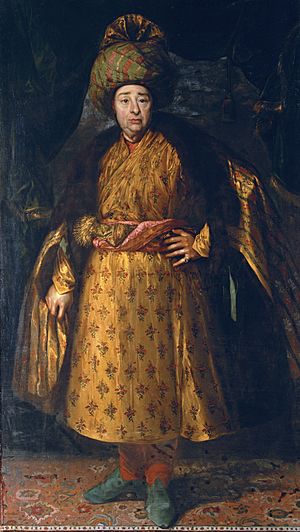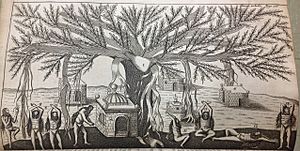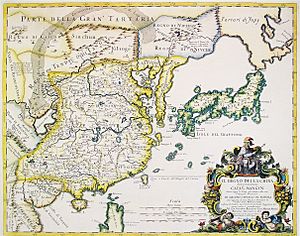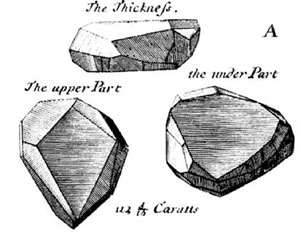Jean-Baptiste Tavernier facts for kids
Jean-Baptiste Tavernier (1605–1689) was a famous French gem merchant and traveler from the 1600s. He traveled a huge distance, about 60,000 leagues, on six long trips to places like Persia (modern-day Iran) and India. He made these journeys between 1630 and 1668. In 1675, he published a book about his adventures called Les Six Voyages de Jean-Baptiste Tavernier (Six Voyages). He wrote this book because King Louis XIV of France asked him to.
Tavernier was born in Paris, France. His family were French Protestants called Huguenots. They had moved to Antwerp to escape problems, but later returned to Paris. His father and brother were both mapmakers. Even though Jean-Baptiste learned about maps and drawing, he loved to travel more than anything. As a teenager, he traveled a lot around Europe and learned many languages.
He is most famous for finding or buying a huge 116-carat blue diamond in 1666. He later sold this diamond, known as the Tavernier Blue, to King Louis XIV in 1668. The king paid a lot of money for it and also made Tavernier a nobleman. This famous gem was later recut and became the Hope Diamond, which you can see today!
In 1669, Tavernier bought a large estate called Aubonne in Switzerland. He became the Baron of Aubonne. Tavernier's writings show that he was a very good observer of people and cultures. His book Six Voyages became a bestseller and was translated into many languages. Even today, experts use his book to learn about that time period.
Contents
Early Life and First Adventures

Jean-Baptiste Tavernier loved hearing stories about faraway places from his father's house. This made him want to travel from a young age. By the time he was sixteen, he had already visited England, the Netherlands, and Germany.
In 1624, when he was eighteen, Tavernier started working for the Viceroy of Hungary. After about four and a half years, he wanted to explore more. He joined the Duke of Rethel and traveled to Mantua, where he worked as an artillery officer.
The next year, Tavernier worked as a translator for an Irish soldier named Colonel Walter Butler. Tavernier wrote in his book that he left Butler's group in 1630. He wanted to go to a special ceremony in Regensburg, Germany. He had already seen many countries like Italy, Switzerland, Germany, Poland, and Hungary, and he could speak their main languages.
First Journey to the East
Tavernier was very excited to visit the East. In Regensburg, he joined two French travelers who were going to the Levant (the eastern Mediterranean region). With them, he reached Constantinople (modern-day Istanbul, Turkey) in early 1631. He stayed there for eleven months.
From Constantinople, he traveled through places like Tokat, Erzurum, and Yerevan. He finally reached Safavid Persia (modern-day Iran). The farthest he went on this first trip was Isfahan, a major city in Persia. He returned to Paris in 1633, traveling through Baghdad, Aleppo, Malta, and Italy.
Later Journeys and Discoveries
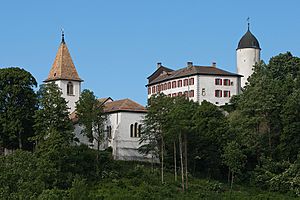
In September 1638, Tavernier started his second journey. This trip lasted until 1643. He traveled through Aleppo to Persia and then to India. He went as far as Agra and the Kingdom of Golconda. He visited the court of the Great Mogul, Emperor Shah Jahan. This was also his first visit to the famous diamond mines.
He made four more journeys after this. On these later trips, Tavernier traveled as a very important merchant. He traded expensive jewels and other valuable goods. His main customers were the most powerful princes in the East.
On his third journey (1643–1649), he traveled all the way to Java (an island in Indonesia). He returned by sailing around the Cape of Good Hope at the southern tip of Africa.
His fourth voyage (1651–1655) took him to many places, including Alexandretta, Aleppo, Bandar Abbas, Masulipatam, Gandikot, Golkonda, Surat, Ahmedabad, and even parts of Burma (Myanmar). He then returned to Bandar Abbas and Isfahan before heading back to Paris.
During his last two voyages (1657–1662 and 1664–1668), he mainly stayed in India. The details of these trips are sometimes unclear. However, they helped him gain amazing knowledge of trade routes in the East. He also became good friends with many powerful Eastern rulers.
These last trips also made him very rich and famous back home in France. He was even introduced to King Louis XIV of France. In 1662, Tavernier married Madeleine Goisse, whose father was a jeweler in Paris. He was given noble titles on February 16, 1669. The next year, he bought the large estate of Aubonne in Switzerland for a lot of money.
Tavernier's Writings
After settling down with his wealth, Tavernier focused on writing about his travels. It seems King Louis XIV wanted him to do this. Tavernier wasn't a scientist, but he knew a lot about trade. This knowledge was very useful to the public.
He worked with a writer named Samuel Chappuzeau. First, he published a book about the inside of the Grand Sultan's palace in Constantinople in 1675. This was based on his visits during his first and sixth journeys.
This book was followed by his most famous work, Les Six Voyages de J. B. Tavernier (2 volumes, Paris, 1676). He also published a follow-up book in 1679. This last book included information about Japan and Tongking (Vietnam), which he learned from other merchants and his brother Daniel. It also contained strong complaints against the Dutch East India Company, who he felt had treated him unfairly.
Historians and geographers highly value Tavernier's work. His books give detailed information about the places he visited from 1631 to 1668. They also describe his meetings with important people when there wasn't much reliable information from the Near East and Asia. Even though some people have questioned his accuracy, his observations about gems are considered very trustworthy.
Later Years and Death
Not much is known about Tavernier's final years. It was a difficult time for Protestants in France. In 1684, Tavernier traveled to Brandenburg (part of modern-day Germany). He went there because Frederick William I, the Elector of Brandenburg, wanted to start his own East India Company. The Elector wanted Tavernier to be his ambassador to India. He even gave Tavernier honorary titles. However, the plan didn't work out.
In 1679, King Louis XIV began to make life harder for his Protestant subjects. In January 1685, Tavernier was able to sell his castle in Aubonne. This was good timing, because in October of that year, Louis XIV canceled the Edict of Nantes. This law had protected French Protestants. Louis then took away noble titles from Protestant noblemen who refused to become Catholic. Tavernier was technically a subject of the Duke of Savoy, but Louis threatened to invade the Duke's land if he didn't follow his lead.
In 1687, even though there was a rule against Protestants leaving France, Tavernier left Paris and went to Switzerland. In 1689, he traveled through Berlin and Copenhagen. He then entered Russia with a special passport. He might have planned to travel to India by land. We don't know if he met Czar Peter, who was only 17 at the time. Tavernier, like all foreigners in Moscow, had to live in the foreign quarter. Czar Peter was very interested in everything foreign and spent a lot of time there. Tavernier arrived in Moscow in early 1689. Since Tavernier was a famous person, it's likely they met.
Tavernier died in Moscow in 1689, when he was eighty-four years old. He was known as a tireless traveler and the most important diamond dealer of his time. His amazing book, written over 300 years ago, tells the stories of many important gems that people still talk about today.
Legacy
Tavernier's travel accounts have been printed and translated many times. However, the order of events in his books can be confusing. This is because he combined notes from different trips about the same routes. He mainly wanted to create a guide for other merchants.
Experts like Charles Joret and Valentine Ball have carefully tried to understand the timeline of Tavernier's life. His life is still a bit of a mystery in some parts.
Tavernier was the subject of an English film called The Diamond Queen (1953).
For the 400th anniversary of Tavernier's birth in 2005, a Swiss filmmaker named Philippe Nicolet made a movie about him called Les voyages en Orient du Baron d'Aubonne. Another Swiss artist, Jacques Basler, created a life-sized bronze statue of Tavernier. It looks out over Lake Geneva at the Hotel Baron Tavernier. This hotel also has a permanent display of all his drawings and old documents.
A gem expert and historian named Richard W. Wise wrote a historical novel called The French Blue. This book uses Tavernier's Les Six Voyages as a guide. It tells the story of Tavernier's life and travels, leading up to when he sold the Great Blue Diamond to King Louis XIV.
See also
In Spanish: Jean-Baptiste Tavernier para niños


